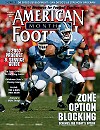AMERICAN FOOTBALL MONTHLY THE #1 RESOURCE FOR FOOTBALL COACHES
Article CategoriesAFM Magazine
|
The Strength ReportDeveloping the Explosive Athlete: Linebackersby: Shannon Turley Director of Athletic Performance Training, University of San Diego © More from this issue Our philosophy and strategy at the University of San Diego is to develop players that are willing to persistently work towards achieving their goals and dreams, that believe if they dedicate themselves to their preparation they will deserve to be confident and expect to be successful. We teach players to perform with the fundamental habits that will enable them to be successful in their football career and life: by implementing a comprehensive program that teaches players to pay attention to the details of their preparation in every aspect of their training, such as technique, effort, accountability, mental discipline, teamwork, leadership and commitment; and through specific, progressive, variable and precise training that is individually designed to reduce the risk and severity of potential injury while also improving overall....The full article can only be seen by subscribers. Subscribe today!
|
|
|||||||
| HOME |
MAGAZINE |
SUBSCRIBE | ONLINE COLUMNISTS | COACHING VIDEOS |
Copyright 2025, AmericanFootballMonthly.com
All Rights Reserved





